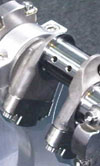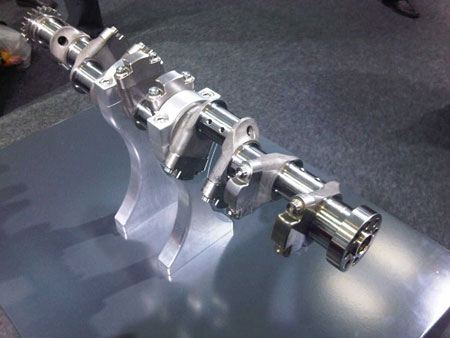Further thoughts on Crankshaft Oiling
 The previous article looked at the recent trend in crankshaft lubrication commonly known as the 'nose-feed' method. In that article, the basics of the concept were explained, along with some of the perceived advantages of using this method of providing lubrication to the connecting rod big ends and possibly the crankshaft main bearings too.
The previous article looked at the recent trend in crankshaft lubrication commonly known as the 'nose-feed' method. In that article, the basics of the concept were explained, along with some of the perceived advantages of using this method of providing lubrication to the connecting rod big ends and possibly the crankshaft main bearings too.
When feeding the connecting rod's big-end bearings with oil in the 'conventional' manner of pumping in oil via the main bearing journals, we need to provide a groove in the bearing shell so that the big end is fed continuously and doesn't suffer from having an intermittent supply of lubrication. Therefore, in making space for the groove in the bearing shells, the bearing becomes wider.
The implication of this may be that, where loads are high and space is limited, the main bearing fillet radii might not be as generous as we would like. Where no groove is needed a narrower bearing can be made to support the service loads, thus leaving room for generous fillet radii.
These more generous fillet radii lead to a lower stress concentration factor and therefore a greater factor of safety against fatigue failure in this area of the crankshaft. Arai's work which is referenced in Peterson's Stress Concentration Factors* shows the effect of increasing fillet radius for a simple case over a range of crankshaft overlap ratios.
Feeding the crankshaft via the nose requires a sealing arrangement on the crankshaft axis at the opposite end to the output. The oil needs to be supplied on the crankshaft axis, and this can be via a static tube poking into the crankshaft nose or by an extension of the crankshaft poking into a static part of the oil supply. In either case, a seal must be provided.
In the first case, where a tube protrudes into the crankshaft nose, the seal will be in the crankshaft and rotating with it; in the second case the seal is static. In the first case we need to ensure that, at maximum operating speed, the load on the seal lip is not relieved by centripetal forces to the extent that the seal no longer works as expected.

The effect of this might only be to spill excessive oil into the crankcase, but equally it might temporarily starve the crankshaft of oil. Given that this is most likely to happen at high engines speeds, it is critical to ensure sufficient sealing lip loads in all circumstances. This will clearly be more of a concern when the engine speed is high and the seal is large. We might therefore conclude that it would be better to have a static seal, although both types have been used successfully in recent racing engines.
Although centripetal forces might concern us in this instance, they can be used to good effect in improving the quality of the oil flow in the crankshaft, and in the next article I will look at how we might use these forces to our advantage.
* W.D. Pilkey and D.F. Pilkey, Peterson's Stress Concentration Factors, 3rd edition, Wiley 2008, ISBN: 978-0-470-04824-5, see page 451 and relevant text
Fig. 1 - This F1 crankshaft has no evidence of any oil holes on the main bearings, and is of the nose-feed type
Written by Wayne Ward